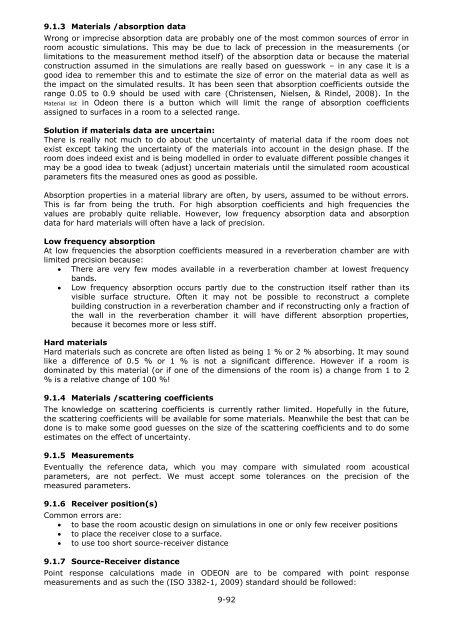Download - Odeon
Download - Odeon
Download - Odeon
You also want an ePaper? Increase the reach of your titles
YUMPU automatically turns print PDFs into web optimized ePapers that Google loves.
9.1.3 Materials /absorption data<br />
Wrong or imprecise absorption data are probably one of the most common sources of error in<br />
room acoustic simulations. This may be due to lack of precession in the measurements (or<br />
limitations to the measurement method itself) of the absorption data or because the material<br />
construction assumed in the simulations are really based on guesswork – in any case it is a<br />
good idea to remember this and to estimate the size of error on the material data as well as<br />
the impact on the simulated results. It has been seen that absorption coefficients outside the<br />
range 0.05 to 0.9 should be used with care (Christensen, Nielsen, & Rindel, 2008). In the<br />
Material list in <strong>Odeon</strong> there is a button which will limit the range of absorption coefficients<br />
assigned to surfaces in a room to a selected range.<br />
Solution if materials data are uncertain:<br />
There is really not much to do about the uncertainty of material data if the room does not<br />
exist except taking the uncertainty of the materials into account in the design phase. If the<br />
room does indeed exist and is being modelled in order to evaluate different possible changes it<br />
may be a good idea to tweak (adjust) uncertain materials until the simulated room acoustical<br />
parameters fits the measured ones as good as possible.<br />
Absorption properties in a material library are often, by users, assumed to be without errors.<br />
This is far from being the truth. For high absorption coefficients and high frequencies the<br />
values are probably quite reliable. However, low frequency absorption data and absorption<br />
data for hard materials will often have a lack of precision.<br />
Low frequency absorption<br />
At low frequencies the absorption coefficients measured in a reverberation chamber are with<br />
limited precision because:<br />
There are very few modes available in a reverberation chamber at lowest frequency<br />
bands.<br />
Low frequency absorption occurs partly due to the construction itself rather than its<br />
visible surface structure. Often it may not be possible to reconstruct a complete<br />
building construction in a reverberation chamber and if reconstructing only a fraction of<br />
the wall in the reverberation chamber it will have different absorption properties,<br />
because it becomes more or less stiff.<br />
Hard materials<br />
Hard materials such as concrete are often listed as being 1 % or 2 % absorbing. It may sound<br />
like a difference of 0.5 % or 1 % is not a significant difference. However if a room is<br />
dominated by this material (or if one of the dimensions of the room is) a change from 1 to 2<br />
% is a relative change of 100 %!<br />
9.1.4 Materials /scattering coefficients<br />
The knowledge on scattering coefficients is currently rather limited. Hopefully in the future,<br />
the scattering coefficients will be available for some materials. Meanwhile the best that can be<br />
done is to make some good guesses on the size of the scattering coefficients and to do some<br />
estimates on the effect of uncertainty.<br />
9.1.5 Measurements<br />
Eventually the reference data, which you may compare with simulated room acoustical<br />
parameters, are not perfect. We must accept some tolerances on the precision of the<br />
measured parameters.<br />
9.1.6 Receiver position(s)<br />
Common errors are:<br />
to base the room acoustic design on simulations in one or only few receiver positions<br />
to place the receiver close to a surface.<br />
to use too short source-receiver distance<br />
9.1.7 Source-Receiver distance<br />
Point response calculations made in ODEON are to be compared with point response<br />
measurements and as such the (ISO 3382-1, 2009) standard should be followed:<br />
9-92
















